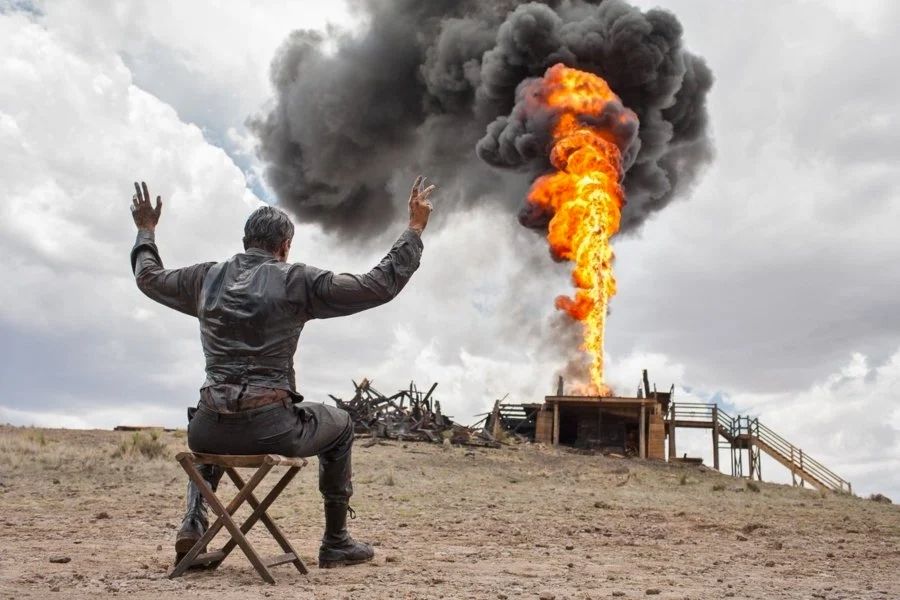By the time that There Will Be Blood was released in 2007, there weren’t many sights left in the world that a camera hadn’t been pointed at, particularly in the world of westerns. This tricky predicament has meant that modern cinema is more of a postmodern collage than an original work of fresco. However, as filmmaker Jim Jarmusch once declared: “Nothing is original. Steal from anywhere that resonates with inspiration or fuels your imagination.”
The inspiration for Paul Thomas Anderson‘s erupting geyser of oil comes from one of his favourite films, the old epic western Giant starring James Dean, where a similar, albeit far less ferocious spring of oil comes bursting out of the ground. In his own movie, this would represent the moment where Daniel Plainview happened upon black gold, but his fistfuls of silver coins that would follow came at the cost of his sons hearing as he suffers a catastrophic blow to the head during the initial blast.
The scene is not only a pivotal moment in terms of diegesis but also a cinematic triumph. However, in a movie where the fantastic naturalistic aesthetic had a starring role, capturing something so ambitious with the same brush strokes was always going to be an almighty challenge. In order to maintain the naturalistic feel, they had to go about it in a very natural manner – light the thing up!
As special-effects supervisor Steve Cremin explained to the ASC: “We used petroleum products, diesel fuel and gasoline in different proportions depending on the shot. For day scenes, we used a mix that would create more smoke. Smoke doesn’t read at night, but if we wanted some night shots to be brighter, we just changed the mix.”
As it happens, the smoke from the burning fountain of oil ended blowing a few miles down the road to where the Coen brothers were filming No Country for Old Men, and it meant that they had to call a halt to filming because their shots were suddenly shrouded in black smoke. This torrent of smoke also signified the huge environmental issue that set designers had to mitigate.
As Cremin goes on to explain: “When you do this kind of stunt, you’re subjected to environmental oversight the whole time. No fuel can be shot through the nozzle unless it’s ignited; you can’t let any fluid hit the ground, because then you’re liable for a toxic spill. Before we shot anything, we had to test the whole area to verify the levels of petroleum in the soil. Once we’d finished the stunt, we had to pull soil samples within a 150-foot radius [of the fuel jet] to prove we hadn’t added petroleum to the soil.”
As is clearly the case, this pivotal scene was very much a one-strike deal that had to be met head one, not least because Paul Thomas Anderson isn’t a man to be cutting corners. “The original proposal was to make the derrick out of steel and put a veneer on it that could burn,” Cremin explains. “That would have allowed us to put out the fire and replace the veneer for subsequent takes, but building a steel derrick would have been more expensive and time-consuming. And Paul just prefers guerrilla-filmmaking tactics: ‘Let’s just light it up and go for it.”
Thus, what can be seen on-screen is exactly what went down while filming. As the oil derrick caught aflame, it became clear that every shot would have to be captured in one go. One of the most mind-blowing segments on this front is when Daniel Day-Lewis rushes to assist a man failing to dislodge a wooden pin with a sledgehammer; both the actor’s frantic attempts and Day-Lewis almost copping a sledgehammer to the midriff as he rushed to assist were entirely real.
By nightfall, Paul Thomas Anderson had to say he was happy with the amazing shots that Robert Elswit and his team had in the can, and they tugged at the damaged knee of the derrick and it all came tumbling down seamlessly. In the process, they crafted one of the most iconic shots in cinema history, one that captures the visceral energy and primordial pleasure of bringing the imagination to life.
